Photokina 2008 Final Thoughts
 Photokina is over for another 2 years, so we’ve looked back at some of the most notable developments from the World’s biggest photography show.
Photokina is over for another 2 years, so we’ve looked back at some of the most notable developments from the World’s biggest photography show.
Leica S System
Undoubtedly the greatest surprise of this year’s Photokina was Leica’s announcement of the new S system. The German manufacturer did not simply launch a new, high-resolution camera with an assortment of lenses to go with it. They did not simply introduce a new mount either. Instead they announced a completely new camera format, something that hasn’t happened since the debut of the FourThirds system five years ago.
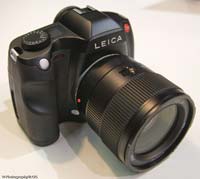 There is a fundamental difference though. This does not lie in the fact that the S system uses a larger, rather than smaller, sensor than 35mm “full frame” (the custom-made Kodak sensor measures 30x45mm, which has 56% more surface area than a 35mm “full frame” sensor and is exactly half the nominal size of a 6x4.5cm frame on 120 type film). The real difference is in the target market of the two formats. FourThirds did not simply aim to seduce other system users, but could also count on people moving up from compacts. By contrast, those who might be interested in the S system are likely to already have some heavy investment in another brand, be it Canon, Nikon, or Hasselblad. Leica cannot seriously expect anyone to buy into the S system on a whim. Prospective S2 owners will have to consider either using it alongside their existing system or ditching the latter completely in favour of it. Given the history of Leica product pricing, the quality of the prototype we tried out at Photokina and the Leica spokesperson’s indication that it won’t be a “camera for the average Joe”; it’s safe to assume that either of the above options is going to be costly.
There is a fundamental difference though. This does not lie in the fact that the S system uses a larger, rather than smaller, sensor than 35mm “full frame” (the custom-made Kodak sensor measures 30x45mm, which has 56% more surface area than a 35mm “full frame” sensor and is exactly half the nominal size of a 6x4.5cm frame on 120 type film). The real difference is in the target market of the two formats. FourThirds did not simply aim to seduce other system users, but could also count on people moving up from compacts. By contrast, those who might be interested in the S system are likely to already have some heavy investment in another brand, be it Canon, Nikon, or Hasselblad. Leica cannot seriously expect anyone to buy into the S system on a whim. Prospective S2 owners will have to consider either using it alongside their existing system or ditching the latter completely in favour of it. Given the history of Leica product pricing, the quality of the prototype we tried out at Photokina and the Leica spokesperson’s indication that it won’t be a “camera for the average Joe”; it’s safe to assume that either of the above options is going to be costly.
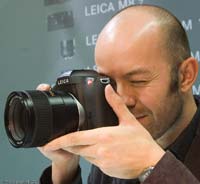 That alone should not come as a surprise, but costly investments always need to be justified. So can the S system demonstrate benefits strong enough for a sizeable community of professional photographers to bite the bullet and eBay their Hasselblad bodies, finders, backs and lenses? Or their Canon / Nikon DSLRs, optics and flashes? Only time can tell. The Leica S2 we got to try out at Photokina certainly exuded a surprising degree of maturity for a prototype – it was fully functional, very well made and altogether convincing. We loved the robust build, huge and bright viewfinder, ergonomic hand-grip, nice display, fast and accurate autofocus and – for a medium-format camera – overall speedy operation. We also thought the system, though heavier than its DSLR counterparts, certainly looked more portable than existing medium-format options. This alone is no small benefit for landscape photographers, for example, who often work in remote areas and have to carry a heavy load of non-photographic gear as well. Add to this the massive resolution of the sensor and the option to use a 24mm lens, which is wider than pretty much anything you can get in medium-format, and Leica’s S system starts to make real sense. Portability combined with high resolution and a fast AF system is also very attractive to fashion and commercial photographers working on location outdoors. In-demand wedding photographers shooting expensive weddings can now use a single system for both studio shots and the event itself.
That alone should not come as a surprise, but costly investments always need to be justified. So can the S system demonstrate benefits strong enough for a sizeable community of professional photographers to bite the bullet and eBay their Hasselblad bodies, finders, backs and lenses? Or their Canon / Nikon DSLRs, optics and flashes? Only time can tell. The Leica S2 we got to try out at Photokina certainly exuded a surprising degree of maturity for a prototype – it was fully functional, very well made and altogether convincing. We loved the robust build, huge and bright viewfinder, ergonomic hand-grip, nice display, fast and accurate autofocus and – for a medium-format camera – overall speedy operation. We also thought the system, though heavier than its DSLR counterparts, certainly looked more portable than existing medium-format options. This alone is no small benefit for landscape photographers, for example, who often work in remote areas and have to carry a heavy load of non-photographic gear as well. Add to this the massive resolution of the sensor and the option to use a 24mm lens, which is wider than pretty much anything you can get in medium-format, and Leica’s S system starts to make real sense. Portability combined with high resolution and a fast AF system is also very attractive to fashion and commercial photographers working on location outdoors. In-demand wedding photographers shooting expensive weddings can now use a single system for both studio shots and the event itself.
On the other hand, the question of whether the brave introduction of an entirely new format and system can ever be profitable for a company that nearly went bust a couple of years ago still lingers. Whichever way you look at it, Leica is addressing a fairly small market that is already being served by an impressive assortment of great products. And many of these products have already started to fall in price, making it harder than ever to get a decent return on what must have been a massive investment in the S2 platform.
Micro FourThirds and the Panasonic Lumix DMC-G1
Leica’s announcement of the S system might have been the greatest surprise at this year’s Photokina, but the most talked-about development in the camera industry was probably the launch of Micro FourThirds and its first representative, the Panasonic Lumix DMC-G1.
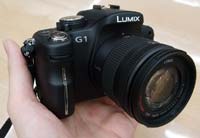 Micro FourThirds itself had been announced in the run-up to the show, some one-and-a-half months before Photokina kicked off, and the Panasonic G1 was no complete novelty by the time the doors opened, either. They still attracted lots of attention because this was the first opportunity for the general public, and most of the press as well, to actually try out a working Micro FourThirds product.
Micro FourThirds itself had been announced in the run-up to the show, some one-and-a-half months before Photokina kicked off, and the Panasonic G1 was no complete novelty by the time the doors opened, either. They still attracted lots of attention because this was the first opportunity for the general public, and most of the press as well, to actually try out a working Micro FourThirds product.
The idea of an interchangeable-lens system that uses an electronic viewfinder had emerged years ago, and has been the topic of some heated discussions on photography-related discussion forums ever since. Many have expressed their interest in such a system, while others dismissed it completely, saying that EVFs would never become remotely as good as a true optical TTL finder. Their video lag would make it impossible to capture fleeting moments and such cameras would, for reasons inherent in their design, have to make do with slow contrast-detect autofocus, rendering them almost useless for action shooting.
Our extensive hands-on experience with the Panasonic Lumix DMC-G1 has convinced us that the latter group’s worries were largely unfounded. They were based on existing technologies and the presupposition that their limitations could not be overcome. Panasonic have apparently thought otherwise. The electronic viewfinder in the G1 is really like nothing that has come before it, being large, smooth and of extremely high resolution. The new technology developed by Panasonic has made it possible to do away with the alternating columns of red, green and blue pixels in the viewfinder that have made any previous EVFs frankly unpleasant and unnatural to look at.
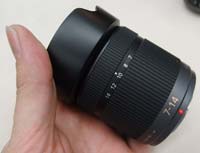 It is also notable how the company has solved the problem of manual focussing, a task that was quite difficult to accomplish with previous EVF cameras. As soon as you touch the manual-focus ring on the lens attached to the camera, the central part of the image gets magnified to 100%, so you can see details at the pixel level. We’ve seen this before, but it is the high-resolution, smooth EVF combined with the large sensor that makes this solution really work in the G1. Once you are done with the focussing, a half-press of the shutter release takes you back to the big picture, literally.
It is also notable how the company has solved the problem of manual focussing, a task that was quite difficult to accomplish with previous EVF cameras. As soon as you touch the manual-focus ring on the lens attached to the camera, the central part of the image gets magnified to 100%, so you can see details at the pixel level. We’ve seen this before, but it is the high-resolution, smooth EVF combined with the large sensor that makes this solution really work in the G1. Once you are done with the focussing, a half-press of the shutter release takes you back to the big picture, literally.
The autofocus was another big and pleasant surprise. Yes, it is of the contrast detect type, but it’s fast. Panasonic claim focusing speeds as quick as 0.3 second, which is in the same league as an entry-level DSLR equipped with a kit lens, if not faster. Again, our own experience is in accordance with the company’s claims – we could hardly believe our eyes when the subject popped into focus in almost no time, upon a half-press of the shutter release button. This definitely was the case with the 14-45mm lens at all focal lengths and the 45-200mm telezoom at the short end. The latter lens took more time to lock focus at the long end, but the difference was not dramatic. Hunting was a rare occurrence, even in the dull lighting of an overcast Cologne day and even darker conditions of the Panasonic booth, which also bodes well for the new AF system.
In fact, contrast-detect autofocus has always had certain advantages over the phase-difference-detect systems employed by SLRs, namely much greater precision and a complete lack of front- or back-focussing issues; but these have, until now, been overshadowed by its slow speed. Now, with this obstacle removed, contrast-detect AF emerges as a true rival for the venerable phase-detect solution, at least in consumer-oriented cameras. Finally, the mirror-less design of the G1 makes for very quiet operation – once you find out how to disable those ubiquitous electronic beeps, that is –, a distinct advantage over any SLR. In fact, it can be argued that Micro FourThirds combines the discretion of rangefinders with the speedy autofocus of modern SLRs and the WYSIWYG nature of EVF cameras, all in a snappy, high-performance package.
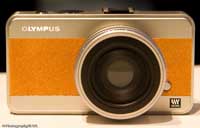 Olympus have not yet produced anything close to a finished Micro FourThirds product, but their mock-up unveiled on the press day of the show demonstrates just how small these cameras can get. Since this was one of the promises of the new system, and the Panasonic G1 admittedly didn’t really deliver on this front – being only marginally smaller and the same weight as an Olympus E-4xx DSLR – the message of the Olympus mock-up is important.
Olympus have not yet produced anything close to a finished Micro FourThirds product, but their mock-up unveiled on the press day of the show demonstrates just how small these cameras can get. Since this was one of the promises of the new system, and the Panasonic G1 admittedly didn’t really deliver on this front – being only marginally smaller and the same weight as an Olympus E-4xx DSLR – the message of the Olympus mock-up is important.
In all probability, Micro FourThirds is the first mirror-less interchangeable-lens system in the world, but not the only one we will ever see. Practically every representative of the camera industry we talked to has admitted they were watching the new system with keen interest. Samsung have already announced the development of their own proprietary “hybrid” system, Pentax have expressed an openness toward Micro FourThirds itself, while Nikon said they would watch how the new system performs in the marketplace and adjust their plans accordingly.
The question that many industry insiders we talked to have raised was whether interchangeable-lens EVF cameras would eventually replace SLRs and their optical TTL finders. This seems very unlikely to us. It seems a fairly safe bet that there will always be professional photographers and advanced amateurs who prefer the immediacy of a big and bright optical viewfinder and a high-quality focussing screen – like those we’ve seen in the Sony Alpha DSLR-A900 – over the EVF experience, no matter how the latter technology may evolve in the future. Therefore it appears more likely that the two types of interchangeable lens system will co-exist for a long time, the way view cameras and rangefinders have co-existed with SLRs in the past.
Video Capture in DSLRs
For many years, when someone asked the innocent question, “Can this DSLR shoot movie clips?”, those in the know would condescendingly answer, “No, no DSLR can record video”. And when word came that video capture in DSLRs might just be round the corner, many traditionalists scoffed at the idea, dismissing it as “yet another gimmicky feature” for entry-level models.
To the surprise of many, then, both Nikon and Canon introduced this capability in semi-professional models, the D90 and the EOS 5D Mark II, respectively. The D90 can shoot 1280x720 Progressive HD video and stores it in Motion JPEG format, while the 5D Mk II takes it all the way to capturing 1920x1080 Progressive Full HD movies, and compresses them using the highly advanced H.264 codec.
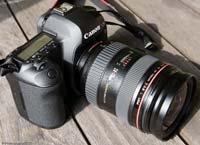 But, as with every new type of product – and an interchangeable-lens DSLR capable of shooting video definitely classifies as a new type of product –, the question arises, “Who are its target group?” When we think of the potential buyers of a semi-professional DSLR, we imagine them to be people who take still photography seriously, either as advanced amateurs or professional still photographers. Many of these people, while being experts at what they do, don’t even know the jargon that videographers use. Are they going to embrace this new technology? Or will they accept it as an added bonus in cameras that offer other benefits over their predecessors that warrant the upgrade anyway?
But, as with every new type of product – and an interchangeable-lens DSLR capable of shooting video definitely classifies as a new type of product –, the question arises, “Who are its target group?” When we think of the potential buyers of a semi-professional DSLR, we imagine them to be people who take still photography seriously, either as advanced amateurs or professional still photographers. Many of these people, while being experts at what they do, don’t even know the jargon that videographers use. Are they going to embrace this new technology? Or will they accept it as an added bonus in cameras that offer other benefits over their predecessors that warrant the upgrade anyway?
Both reactions are possible, but I have a strong feeling that these cameras are in fact meant to break into completely new markets as well- they may be of interest to serious video- and cinematographers. No, I’m not saying the next Hollywood blockbuster is going to be shot using a digital SLR and edited on a Mac, but indie filmmakers might find these cameras more than interesting, for at least two reasons. Firstly, they can use all those exciting lenses, from ultrawides to fisheyes to tilt-shift optics and more. Secondly, they get to play with depth of field the way they never could. Most camcorders use small sensors, and even professional 35mm motion picture cameras shoot frames that are considerably smaller than the 24x36mm, 35mm full frame in still photography. These two reasons alone could attract the interest of a whole range of creative filmmakers, from independent cinematographers to those directing television commercials professionally.
Nikon and Canon aren’t the only companies that are trying to marry high-quality still photography with professional filmmaking. In fact, they are now facing an unlikely competitor, a company whose name you might never have heard: RED. Its founder, Jim Jannard, recently announced on Red’s company forums that they “are developing for late 2009, a replacement for DSLRs… it is strategically targeted at the DSLR space. As Nikon and Canon release their 720P and 1080P, respectively, DSLRs with video capture… RED has a more advanced view of the future. We look forward to rapidly pushing the ‘big guys’ along in feature sets and capabilities.” At present, this is pretty much all that we know about their plans. Stay tuned though – it seems there’s much more to come…
Fujifilm FinePix Real 3D System
A completely unexpected technology announced at Photokina 2008 was Fujifilm’s all-new Real 3D system, illustrated by working prototypes of a 3D camera, a 3D viewer and even 3D prints.
 3D imaging has long been something of a Holy Grail for the camera and motion picture industry. Right from the earliest days of photography, stereo photographs gave the impression of a three-dimensional image when viewed through a stereoscope. Holograms started their career in the middle of the 20th century, thanks to Nobel prize awardee Dénes Gábor. Other types of 3D photographs and movies could be admired with the use of special glasses. Still, the kind of hyper-realistic 3D recording R2D2 played to a stunned Luke Skywalker and Obi-wan Kenobi in the desert of Tatooine somehow hasn’t made its way to planet Earth yet.
3D imaging has long been something of a Holy Grail for the camera and motion picture industry. Right from the earliest days of photography, stereo photographs gave the impression of a three-dimensional image when viewed through a stereoscope. Holograms started their career in the middle of the 20th century, thanks to Nobel prize awardee Dénes Gábor. Other types of 3D photographs and movies could be admired with the use of special glasses. Still, the kind of hyper-realistic 3D recording R2D2 played to a stunned Luke Skywalker and Obi-wan Kenobi in the desert of Tatooine somehow hasn’t made its way to planet Earth yet.
Fujifilm’s Real 3D technology does not promise to go that far either, but what we saw in their Photokina booth still looked interesting, and the company absolutely deserves kudos for pursuing an old dream armed with new technology. The prototype 3D camera, which utilised two lenses and two CCDs, had a rear monitor that displayed the live preview in 3D, although the viewing angle was a little bit narrow. The image taken was also played back in 3D, with a button was provided to toggle between two- and three-dimensional viewing. Our impression was that most still images captured with this device had only a slight 3D effect to them, although with certain subjects, the three-dimensional experience was more intense. This applied to viewing on the camera’s screen as well as to playback on the digiframe-like viewing panel prototypes. The prints looked much like other “depth image prints” we have seen in the past, though they appeared notably sharper. The most favourable impressions were left by the movies, as played back on the viewing panels; they had a real 3D feel to them, which is no small achievement considering we were watching them without wearing any special glasses.
How far Fujifilm will be able to push this technology remains to be seen, but we are already excited by some of the side benefits offered by the use of two lenses and two CCDs in a single camera. Being able to take a wide-angle and a telephoto shot in the same instant, from the same point of view, can open up whole new possibilities. Taking two differently exposed shots, again in the very same instant, may reduce the threat of missing a unique moment because of flawed exposure settings. And being able to take stills with one lens while the other one is used to record a movie clip can give a whole new meaning to the term on-set photography.
However, since Fujifilm were keen on stressing that “no firm plans for commercialisation” have been made, it may be some time until we can make use of these exciting opportunities.
Fujifilm Super CCD EXR Sensor
While other companies tried to make headline news by announcing they had crammed more pixels than ever onto a conventional sensor, Fujifilm is developing an entirely new type of imager, the Super CCD EXR. In the current climate of a raging megapixel war, this approach sounded very refreshing indeed.
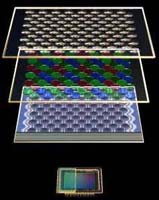 So, what is Super CCD EXR all about? Apparently, Fujifilm have realised that while upping the resolution of compact cameras was still a market requirement, the issues typically associated with fitting an increasing number of ever smaller pixels onto tiny imaging chips – namely, limited dynamic range and lots of noise in high-ISO shots – had to be dealt with. To the company’s credit, Fujifilm have already provided some solutions to this problem, but their high-resolution and wide-dynamic-range sensors have so far formed two different lines, the Super CCD HR and the Super CCD SR, respectively.
So, what is Super CCD EXR all about? Apparently, Fujifilm have realised that while upping the resolution of compact cameras was still a market requirement, the issues typically associated with fitting an increasing number of ever smaller pixels onto tiny imaging chips – namely, limited dynamic range and lots of noise in high-ISO shots – had to be dealt with. To the company’s credit, Fujifilm have already provided some solutions to this problem, but their high-resolution and wide-dynamic-range sensors have so far formed two different lines, the Super CCD HR and the Super CCD SR, respectively.
Fujifilm are now trying to merge these two lines in a new type of sensor that offers the best of both worlds. The new image sensor will be a switchable one, providing the photographer with an opportunity to choose between high resolution, wide dynamic range and low-noise high-ISO image capture while still using the same camera. Super CCD EXR applies three different technologies, dubbed “Fine Capture”, “Dual Capture” and “Pixel Fusion”. “Fine Capture Technology” is nothing new; it basically means all pixels on the sensor are used to contribute towards resolution, just like in conventional imagers. Presumably, this is going to be the default working mode for the sensor.
By contrast, “Dual Capture Technology” comes into play when shooting in harsh light, and your number one priority is capturing detail in both the shadows and the highlights. In order to achieve this, half of the sensor photosites are used to record an image at one exposure and the other half to capture the same shot, at the same time, at a different exposure, much like in previous Super CCD SR chips, except that on the EXR imager, all photosites are of the same size, whereas on the SR variant, the “S” and “R” pixels used to be of different sizes. Right after capture, the two exposures are blended to form a single ‘HDR’ image. By engaging “Dual Capture Technology”, you are trading in some resolution in exchange for increased dynamic range, but this only applies when you actually need it.
Finally, “Pixel Fusion Technology” is basically a new approach to pixel binning, which works by combining two identical-coloured pixels to form a single super-pixel, thereby improving the signal-to-noise ratio. In previous approaches to pixel binning, manufacturers had to make do with combining non-adjacent pixels, because of the design of the traditional Bayer colour filter array. This in turn resulted in the appearance of false colours, whose suppression often caused visible degradation in sharpness. In order to avoid this, the Super CCD EXR got an all-new colour filter, in which same-coloured pixels come in pairs, alleviating the need to combine non-adjacent pixels. This is how “Pixel Fusion” can be different to conventional pixel binning. Again, there is a trade-off, this time between resolution and signal-to-noise ratio, but as with “Dual Capture Technology”, “Pixel Fusion” only need be activated when you need it.
At Photokina, there was no possibility to try out a new camera featuring the Super CCD EXR sensor, but Fujifilm promised to announce a “premium compact” model early next year.
So will Fujifilm’s new sensor ultimately change the rules of the game? Will other manufacturers follow suit? If cameras sporting the new sensor turn out to be a huge market success, they might. But we don’t have high hopes for that, because unlike Fujifilm, most camera manufacturers source their compact camera sensors from third parties. And as long as it is easier for sensor manufacturers to release a higher-resolution version of an existing chip than to bring out a truly new sensor, camera makers will likely remain at their mercy.
Now take a look at our comprehensive Photokina Report. There are 25 in-depth live reports from the show floor, over 100 listings of every significant new product announced before and at Photokina, and our Top 10 pick of the stars of the show.
Words: Zoltan Arva-Toth
Pictures: Mark Goldstein / Zoltan Arva-Toth

Loading comments…